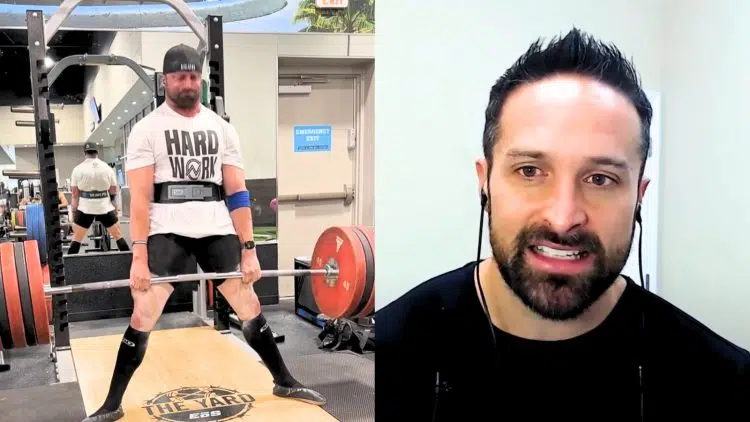Testing himself as a multi-sport athlete, Dr. Layne Norton is uniquely qualified to discuss different training styles. Speaking with Dr. Peter Atita, Norton compared and contrasted the training approaches of powerlifting and bodybuilding.
Aside from modeling and coaching, Dr. Norton has become a standout athlete, having tested the waters of natural bodybuilding as well as powerlifting. Competing in over 10 natural bodybuilding events, Norton proved himself as a top-tier talent, finding success in multiple federations including the INBF, IFPA, and the NGA.
His powerlifting credentials are nothing to scoff at either. He held national records in the deadlift and squat. And while he hasn’t competed since 2015, there’s no denying his strength, endurance, and willpower inside of sanctioned competitions. With a BS in biochemistry and a PhD in nutritional sciences to boot, he continues to contribute to the fitness industry.
Dr. Layne Norton Compares and Contrasts Bodybuilding vs Powerlifting Training Styles
Norton explained that powerlifting and bodybuilding are similar in that both require hypertrophy for success.
Level Up Your Fitness: Join our 💪 strong community in Fitness Volt Newsletter. Get daily inspiration, expert-backed workouts, nutrition tips, the latest in strength sports, and the support you need to reach your goals. Subscribe for free!
“The overlap is that the obvious one is that to look muscular you have to have a lot of muscle and contractile tissue is what’s needed to move weight, right? So, the more there is a little debate about this but the consensus is that hypertrophy does matter for strength training. So, the more muscle you have the more weight you’re going to be able to lift.”
He believes bodybuilding can be more forgiving as a sport because there are multiple ways to grow muscle and build a physique.
“The trade-off is that bodybuilding is a much more forgiving sport in so far as — I mean you can skin the cat a thousand different ways.
If you don’t want to squat, you can hack squat, if you don’t want to hack squat, you can split squat. It is simply about creating tension on that muscle, getting the requisite volume in, and progressive overload.”
Conversely, in powerlifting, while you can perform accessory movements, the sport awards you based on your ‘major lifts,’ like squats, deadlifts, and bench presses.
“When it comes to powerlifting, you can do some accessory movements and whatnot, but you still have to do the major lifts. You still have to be very well trained on the major lifts otherwise you’re not going to perform your best on meet day. ”
According to Norton, bodybuilding demands more from competitors mentally. He underlined the hunger challenges of carrying a low body fat percentage.
“I think that bodybuilding in a way is a little bit more demanding mentally because if people out there listening, if you’ve never been insanely shredded, you cannot imagine the levels of hunger and low energy that these people go through and that I have been through. I’m talking about so hungry that you literally think about it from the moment you wake up to the moment you go to sleep and then it wakes you up at night.”
He explained that during bodybuilding preps, calorie intake drops. In his case, he was tasked with only eating 1,900 calories a day with a body weight of 185 pounds.
“My last show I did, I competed as a Pro natural bodybuilder in 2010. So it’s been a while. And I won the IFPA International the heavyweight division and then I ended up doing the IFPA World Championships and placed top five in the heavyweight division.
It’s difficult because the amount of calories you start on is not what’s going to be what you end up finishing on. I think the lowest my calories got was just around 1,900. Now, that may not sound that bad, but keep in mind, we’re talking about somebody who is probably over 185 pounds of lean body mass. Quite a bit of lean body mass.”
“Two hours [of training] a day, minimum,” adds Layne Norton. “That was pretty much all I had energy for.”
He says bodybuilding presents a different challenge because working for a physique demands a continuous effort throughout the day whereas powerlifting ‘you can kind of leave it at the gym.’
“I think bodybuilding is very difficult, that doesn’t leave you. Powerlifting is difficult in that it beats your body up but once you’re done at the gym other than your rehab work and other stuff, you can kind of leave it at the gym.”
Dr. Norton emphasizes that there are several ways to build muscle as a bodybuilder, while in powerlifting, options are limited because you must excel at just a few major lifts.
“They are really difficult sports but for slightly different reasons. Bodybuilding is more forgiving that it doesn’t really matter what exercises you do as long as you get in enough,” said Norton.
“We’ve seen bodybuilders be successful through every different methodology. Dorian Yates never squatted. He talked about it. He always did leg presses and leg extensions whereas Ronnie Coleman squatted tons of weight. I think that the appeal for me for bodybuilding was that mental challenge.”
From powerlifting and bodybuilding to meaningful dialogues regarding fat loss, Dr. Norton makes it a point to simplify scientific information for his audiences’ benefit. He believes ‘some sort of restriction method’ to be a major key to losing fat.
Carving out a successful career as a bodybuilder and powerlifter, Dr. Norton accepts that both sports come with differing challenges, whether it be mastering selected exercises or pushing through preps with lower body fat percentages.
RELATED: Dr. Layne Norton Breaks Down Nutrition Behind Keto Diet Versus Carnivore Diet









